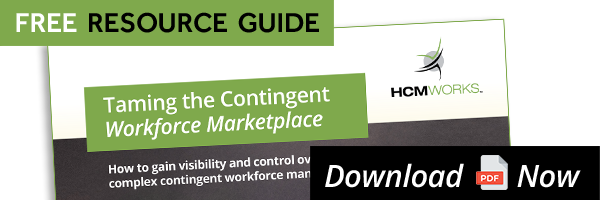Are you responsible for managing your organization's contingent workforce? If so, you'll no doubt be continuously trying to maximize efficiencies and cut costs in order to increase profitability. To do this successfully, you need to address some common contingent workforce challenges.
In this blog, HCMWorks will take a look at the five most common contingent workforce challenges that are wasting money for your business - and what you can do to fix those issues and become more profitable. Before we get into that, let's first take a quick look at the contingent workforce.
What is the contingent workforce?
With labour being one of the biggest expenses in business, it’s only natural that companies would start looking for innovative ways to get work done more efficiently at lower costs, which is how the contingent workforce was born. Contingent workers are defined as freelancers, independent contractors, consultants, or other outsourced and non-permanent workers who are hired on a per-project basis.
Due to the benefits these workers bring, a study from Oxford Economics found that 83 percent of executives are planning to increase their use of contingent, intermittent or consultant workers over the next three years.
Contingent workers can work on site or remotely. However, they are not simply temp workers, this discounts the high-value nature and complexity of today’s contingent workforce. Contingent workers are often highly skilled experts in their fields, and are usually hired specialists to complete specified tasks under a statement of work (SOW) provision.
But once the project is over, they leave, though they may be called back when another project arises. As such, they are not employees and there is no responsibility to provide continuous work on a permanent basis.
So here lies the challenge. Managing a non-permanent workforce requires significant insight and visibility across your entire organization. As the saying goes, you can’t manage what you can’t measure. So a lack of visibility and control of your contingent workforce headcount, and total spend, can translate into challenges for an organization.
Here are five serious contingent workforce challenges you may have that will need to be fixed, to name just a few:
#1 - Are you paying above fair market rates?
Lack of visibility leads to waste. Many organizations don’t have a clear picture of fair market rates for a given category of worker. Better visibility on your current pay rates and the fair market rates for a given class of worker can lead to substantial savings.
#2 - Do you take unnecessary risks?
One of the most overlooked aspects of contingent workforce accounting is the lack of insight into the potential risks associated with various classes of contingent workers. This is particularly true of independent contractors. Greater visibility leads to better governance and compliance with federal, state, provincial and local regulations.
#3 - Do you have poor company decision-making regarding your contingent workforce?
Incorrect information can lead to bad decisions across multiple areas, including workforce rationalization. Businesses that gain full visibility on their contingent workforce pay rates can generate significant savings, often without reducing headcount.
#4 - Do you have poor planning and forecasting?
The cause of last-minute scrambles to fill key contingent labor positions on demand, fluctuates from season-to-season or project-to-project. This kind of poor planning leads to costlier sourcing options, like staffing vendors, to fill urgent and unplanned needs.
#5 - Are your rates of pay inconsistent for your contingent workforce?
It’s common to find organizations paying vastly different rates for the same category and level of resource from one department to another.
How to increase visibility into your contingent workforce
Lack of contingent workforce visibility can potentially represent millions of dollars in needless overpayments and hidden rogue spend, as well as potential liability for misclassification and co-employment challenges. Throw in the risk of class-action lawsuits by contingent workers themselves, and it becomes clear that getting a handle on the full extent of your contingent workforce is a strategic and urgent undertaking.
Here are some steps you should consider:
- Consolidate and centralize – Put information on all your contingent workers in one place, regardless of their type and source. Build a central repository that consolidates all the various types of non-permanent workers across your organization. A vendor management solution (VMS) will help here.
- Catalog, classify and validate – Create a comprehensive job catalogue of all non-permanent positions in your organization. Understand the nature of the work they do for you. Make sure they are properly classified and, if they are independent contractors, verify that they actually qualify to be classified as such. Not everyone who claims to be an IC is eligible to work as an IC.
- Document, educate, propagate – Success depends on managing change. Make sure your managers understand the value of centralizing the management of your contingent workforce. Demonstrate the positive impact on the business. Then roll out best practices across the various departments, divisions and locations.
How a Managed Services Program can help
To achieve all this, many organizations turn to a Contingent Workforce Managed Services Program, often referred to as an MSP. It used to be that MSP solutions were reserved for large enterprises, but now they are accessible to mid-sized organizations across a wide range of industries.
In addition, there are several intermediary solutions that enable you to gain better visibility and control over portions of your contingent workforce, including Independent contractors and directly sourced candidates.
Want a clearer view of your Contingent workforce? Need some help? Ask one of our contingent workforce consultants how HCMWorks can audit your contingent workforce and build a roadmap for greater visibility and control.




